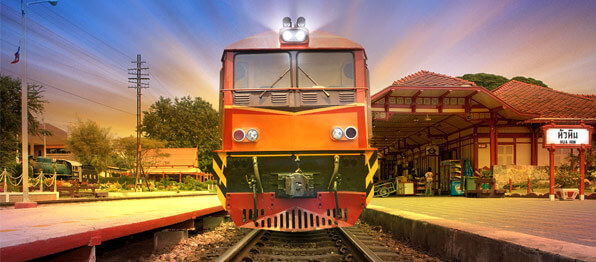 Tuk-Tuk
Tuk-Tuk
Tuk-Tuk is a true national monument in Thailand. Also called 'sam lor', meaning three-wheeled vehicle, Tuk-Tuks are ubiquitous in Bangkok and symbolize the funniest and most colourful aspect of the country. Tuk-Tuks are particularly popular among tourists and Thai citizen as an easy and convenient way to get around the Thai cities where traffic congestion is a real big problem, such as in the centre of Bangkok. Tuk-Tuk's drivers generally use their vehicle even to transport fresh products or other goods around the city in absence of passengers. Tuk-Tuk is a motorized development of the old-fashioned pulled rickshaw, widely used in old times in all South East Asia; its Thai name derives from the particular sound of its small engine, often two-cycle. The Thai Tuk-Tuk has the engine of a motorcycle, 3 wheels. The front seat is for the driver, in a cabin with no doors, behind, there are three seats on a single narrow bench for passengers and it is a little uncomfortable but very funny. Faster than the taxi, at least over short or medium distances, but dangerous in the event of an accident. Be careful what you ask for. Go faster can be fun, but at the same time it can be dangerous. A trip by tuk-tuk in Bangkok is an experience not to be missed. At present days, there are 9,000 tuk-tuks registered to be used as taxis in the capital. Fares vary with the distance traveled, hours, traffic, and the method of payment laid down by the driver. Normally a very short trip will cost between 40 and 70 THB; for longer distances the cost is in the order of 100 THB or a little more. All costs are negotiable, as typical Thai tradition. Be advised, if drivers offer to you a too low tariff for a long route, decline, it is a catch; you will end up surely in a store of gems or in a massage center. Use a map to see where you are going, it is not easy but try it.
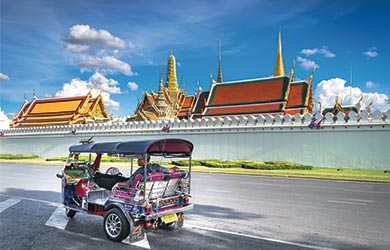


 Song-Thaew
Song-Thaew
The song-thaews are passenger vehicles in Thailand adapted from a pick-up and used as a share taxi. Song-thaew in Thai language literally mean "two rows", reported to two bench seats fixed along either side of the back of the vehicle. A roof to which are attached curtains and plastic sheeting to keep out rain, in some areas of Thailand is closed on the two lateral sides, especially in the north, covers the back of the song-thaew. The access for customers is in the rear of the vehicle, where there are not doors. Song-thaews are part of the informal public transportation system in Thailand and are ubiquitous in all urban areas, with the exception of central Bangkok, small villages, rural areas and even in lots of beach resorts. Song-thaews are used both within cities and for longer routes between towns and villages, carrying indifferently passengers or goods, often together. In some areas, song-thaew have signs indicating their routes, in others is the color of vehicle, which identifies the destination. The system is not easy to understand, even to the locals, therefore always better to ask to the driver. Those within towns usually travel along fixed routes with a set fare, normally between 5 and 10 THB. For routes between city and town or village rates are higher but still economic, between 20 and 40 THB. The costs are negotiable, as typical Thai tradition, for all specific destinations, such as beaches, airports or places of tourist interest outside the city boundaries, and also if you want to travel alone. In addition to fixed stops, you can get a song-thaew along the streets with a simple hand gesture. When it stops, hop in the back and grab a seat on one of the benches. At moment, you want to get out press the buzzer inside the cab, when the song-thaew stops completely jump down and walk to the driver to pay for your ride.
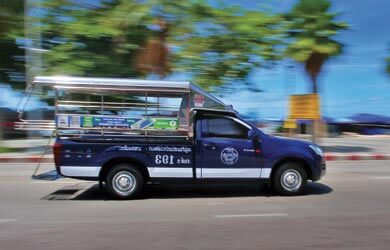
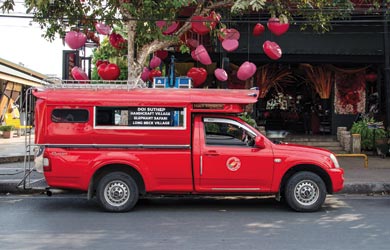
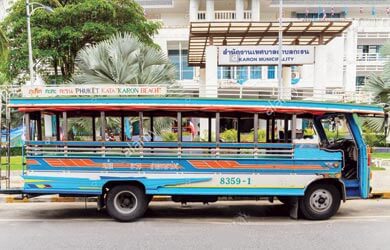

Bangkok Public Transportations
Taxicab is a common form of public transportation in Thailand, highly appreciated and often used both by locals and visitors for their cheapness...
Trains are a good alternative to buses to get around Thailand, although the bus network is more widespread. Trains are slower of buses but cheaper...






